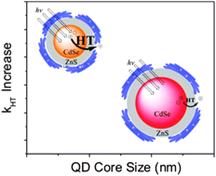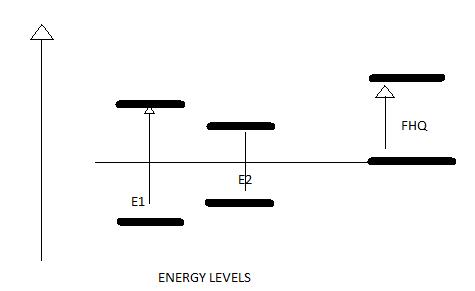Title: IMPROVING SOLAR CELLS EFFICIENCY USING CONJUGATED POLYMER CdSe/ZnS QUANTUM DOTS
Authors: Rijo Baby, 4th Year, BE, Electronics &Communication engineering department
College: St.Anne’s College of Engineering & Technology, Panruti
ABSTRACT
Quantum dots are the innovative semiconductors have the intriguing and useful properties. The size of the quantum dots are showing inversely proportional to the energy level. There are many possible applications in industry/science areas regarding with their different properties. Harnessing energy from sun light is one of the most challenges in this century .low efficiency and high cost of the crystalline solar cells make more challenges to this area. The photonic property of the quantum dots are experimentally proved by the researches 1990’s.the small size of the quantum dots will enhances the charge transfer between them. The study on the single particle indentifies the possible path to improved conversion of sunlight to electricity in photovoltaic devices solar cells. In my theory research paper I introduce the combined material conjugated polymer CdSe/ZnS using hole transfer inhibit blinking, small size and it will highly improve the energy transfer of solar size and the cost and size will reduced effectively.
INTRODUCTION
The researches on quantum starts on1980’s and finds lots of application and properties in different areas. , quantum dotes are semiconductor nano crystals. That are considered as small size and considered as zero dimensions. Its range from 2-10 nano meters (10-50 atoms)[1]. Quantum dots are closely related to atoms than a bulk material because of the discrete quantized energy levels. So we call it as artificial atoms.
Solar cells, light is absorbed the semi conductor when the light shines on the solar cells. it excites an electron which jumps from the valance band of the atom to the conduction band, creating a hole. The neibhouring atoms are forced to fill up the gap due to electric field attraction in the pn junction. The separation of the n and the p region charges builds an electric potential on the pn junction. By an external circuit and providing a path way for the electron and holes to recombine. This flow of electrons and holes create electric current[2]. Today’s many kind of researches going on the solar cells, like nano technology (graphine, cnc) and QD materials. They are trying to improve the power conversion efficiency with low cost.[3]
QUANTUM DOTS WITH PHOTONIC PROPERTY
QD are semiconductor material, they have different, photonic optical etc. they used as biosensors, nano scale transistors. Their properties are different sometimes opposing regarding with way of control the dots optically and electronically. Photovoltaic cells made of QD cells paired with plastic materials like conductive polymers are far easier to make and less expensive than conventional silicon based solar cells[4]. The QD size variations may be a problem of fixing way of property. So the researches find out the smaller size will increase the efficiency of the charge transfer process and narrowed the distribution of the charge transfer rate. So it was closer to the ideal with variability. The whole transfer inhibits blinking keeps the QD highly active longer which is better for the photovoltaic process. Because charges can only be extracted when the QD dotes is on and it also increases the on state and decrease the off state[5].

Fig 1.source from www.rsc.org/chemcomm
CdSe/ZnS A CONDUCTOR POLYMER QD HAVE PROPERTIES TO IMPROVE EFFIENCY
The researches finds that by varying the size of the conjugate polymer of CdSe/ZnS will photo induced hole transfer(fig1). and it will increase the on state and decrease the off state. The size varying risk minimized by the small size core electron transfer method[6]. CdSe/ZnS QD have fluorescence property with λem 485nm ,5mg/ml in toluer /aliphatic amine the property of emitting of single CdSe/ZnS QD near to a dielectric interference the light emitting on the surface of QD . The small size of the CdSe/ZnS semiconductor QD exit produce uniform size distribution QD exhibited very high photoluminescence in combination to other cores. And desirable and disper stability and excellent florescence property .in short the researchers found that the core size tunable hole transfer from a photoexicited CdS/ZnS to a conjugated, FHQ and found hole transfer increases in efficiency with decreasing core size(fig 2[7]). Hole transfer affects the photoluminescence (PL) blinking dynamics of a QD quenches the overall PL intensity and at the same time it increasing the residence time of QD in the ON state. this will help to improving activation of the solar cells.

Fig2 source form www.rsc.org/chemcomm
CONCLUSION
To develop more efficient and low cost solar cells are the big challenge to us. Due to the decrement of non renewable resources .QD are innovative material and easily combined with other materials. Its properties varying with its size .the hole transfer blinking in a small size QD will produced the electron easily; it will keep on the on state and decrease the rate of of state. Its keeps the better performance of the solar cells. The small size single particle CdSe/ZnS wills the one of the combination satisfying the above properties and using this we can develop a cheap and efficient solar cells.
REFERENCES
[1] Photovoltaic Centre of Excellence, School of Photovoltaic and Renewable Energy Engineering, University of New South Wales, Sydney NSW 2052, Australia
[2] Denisa Vlasache Cluster 8: The Chemistry of Life COSMOS 2011
[3] [4] article DOI: 10.1039/c3cc47975g www.rsc.org/chemcomm ,core size dependent hole transfer from a photo excited CdSe/ZnS quantum dot to a conductive polymer
[5][6] http://www.bnl.gov/CFN/news/news.php?a=24487
General recourses are
[7] www.nanowerk.com/nanotechnology_news/newsid=33720.php
[8] Characterization of P3HT:PCBM:CdSe hybrid solar cells Stéphane A. Jotter and, Marc Jobin* hepia,University of Applied Sciences (HES-SO), 4 rue de la Prairie, 1202 Geneve, Switzerland.
